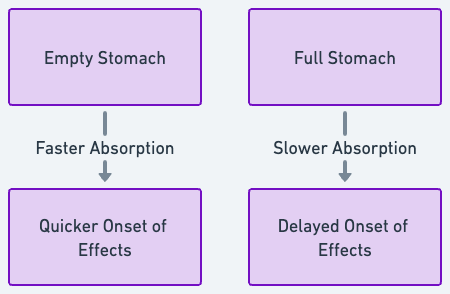
The Role of Stomach Content in Cannabinoid Absorption from Edibles
Cannabis sativa, commonly known as cannabis, is a plant rich in chemical compounds called cannabinoids. These compounds interact with the endocannabinoid system in our bodies through specific receptors. Medical cannabis has gained considerable attention for its potential benefits in treating various ailments, from chronic pain and nausea to epilepsy and multiple sclerosis. When cannabinoids are consumed in edible form, their bioavailability and effectiveness can be influenced by the digestive process.
Stomach and Digestion
Upon ingestion, edibles first make their way to the stomach, an acidic environment containing gastric acid and digestive enzymes. These substances help to break down food and release nutrients, including cannabinoids. Though the stomach’s acidity may slightly degrade cannabinoids, the process isn’t substantial enough to render them ineffective.
Gastric Emptying Time
Cannabinoids eventually transition from the stomach to the small intestine via gastric emptying. This rate varies among individuals and can be influenced by multiple factors, such as meal composition and health status. Faster gastric emptying rates mean cannabinoids reach the bloodstream more quickly.
First Pass Metabolism
Once cannabinoids reach the small intestine, they undergo ‘first pass metabolism,’ a process involving liver enzymes that significantly alters the compounds before they circulate systemically. This stage can impact the composition, concentration, and thus the therapeutic effects of cannabinoids.
Bioavailability
Bioavailability refers to the percentage of a substance that enters the bloodstream to produce its effects. The oral ingestion of cannabinoids tends to result in lower bioavailability than other methods like inhalation. This decrease is primarily due to the first-pass metabolism and individual variability in absorption rates.
Factors Influencing Absorption
Multiple factors can influence the absorption of cannabinoids from edibles, thereby affecting their onset, intensity, and duration. These factors range from the edible’s composition (such as fat content) and co-ingestion with other foods or beverages, to individual metabolism and gastrointestinal health.
Strategies for Enhanced Absorption
Technological advances and formulation strategies aim to improve cannabinoid absorption. For instance, incorporating high-fat ingredients can boost absorption since cannabinoids are lipophilic. Emerging technologies like nanoemulsions and lipid-based formulations also show promise in enhancing cannabinoid bioavailability.
Balancing Efficacy and Research
Understanding how stomach content influences cannabinoid absorption is key for optimizing the therapeutic potential of cannabis edibles. While the digestive journey of cannabinoids can lower their bioavailability compared to other routes, ongoing research and advancements in formulation technology hold promise for future improvements.
📗 Note: The diagram’s your morning smoothie; the book is your five-star brunch. Feast your mind here 📗 📗

Summary Notes
Understanding the Impact of Stomach Content on Edible Cannabis Absorption
The interaction between stomach content and the absorption of cannabinoids from edibles plays a critical role in determining the efficacy, onset, and duration of effects experienced by users. Dietary fats, meal timing, and the presence or absence of food can significantly influence the bioavailability of THC, CBD, and other cannabinoids ingested through edibles.
Research indicates that consuming edibles on a full stomach, especially with high-fat meals, can enhance cannabinoid absorption, potentially leading to more pronounced and sustained effects. Conversely, an empty stomach may result in faster onset times but could also lead to variability in individual experiences and effectiveness.
Understanding these dynamics is essential for both recreational users and medical cannabis patients, informing consumption practices to achieve desired outcomes while minimizing adverse effects. Clinical studies and patient-reported outcomes provide valuable insights into optimizing edible cannabis use, guiding dietary considerations and dosing strategies.
As the cannabis industry continues to evolve, so does the importance of educating consumers, healthcare providers, and regulators on the implications of stomach content for edible cannabis absorption. Future research will further elucidate these interactions, driving innovations in edible formulations and personalized cannabis therapy, ensuring safe and effective use for diverse populations.

